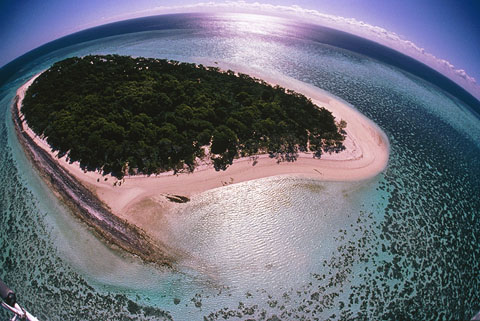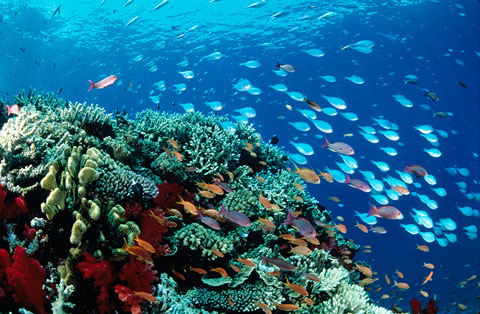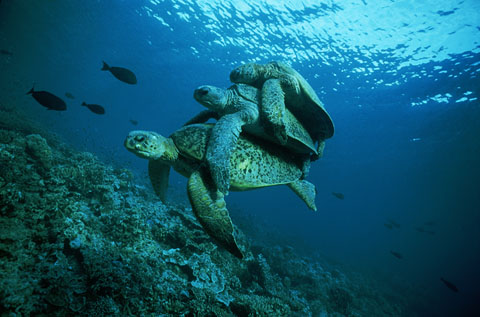|
Heron Island
Christopher P. Baker
This story is available for editorial lease and may not be reproduced in part or in whole without written permission of the author.
I t's a breathtaking half-hour journey by helicopter to Heron Island from Gladstone. Coral Islands slide by. They look exactly as imagination dictates they should: dark green, ringed by an oval of sugary sand and bright turquoise shallows. Soon you close in on a larger, more beautiful island.
With surf pounding on the outer reef. As you step from the helicopter, you're blinded by the shimmering glare of the tropical sun on the sand. It's easy to imagine that you are the first person ever to land, perhaps with the trail of a marine turtle leading up toward the trees as the only sign
that any living creature has passed this way before.

Photo courtesy R. Ian Lloyd
This image may not be copied, downloaded or reproduced in any manner without the express written permission of
the photographer.
Click here
Heron Island straddles the Tropic of Capricorn amid the 12,225 square kilometer Capricornia section of the Great Barrier Reef Park, 534 kilometers north of Brisbane. The coral jewel pokes up a mere three meters from the sapphire sea, and the reef is only a one minute swim from the beach.
Despite its 2,050-kilometer length, there are only two three resort hotels on the Great Barrier Reef. Heron Island has one. It's a perfect place to "go troppo" and receives a fair share of the tens of thousands of visitors who come to the Reef each year. Heron is a tiny island, just sixteen hectares in extent, but in many respects it is a microcosm of the entire reef. Some people go there to snorkel or sunbake, to go scuba diving or sportfishing; others to walk the reef-flats, study the birds or sit in quiet reverie as marine turtles deposit their eggs.
Since 1945, when the Great Barrier Reef recorded just 5,000 overnight visitors, the Reef's popularity as a tourist destination has increased more than sixty-fold, bringing problems of water supply, waste disposal and trampling feet. As a national park and a resort, Heron faces a special challenge: how to cater to the 11,000 tourists who annually descend on this tiny coral cay without allowing man's incursions to disturb the fragile ecological balance?
Heron Island is an inviolate place, perfect for getting close to some of nature's most extravagant sculpture. The fringing reef spreads out from your door: an aquatic version of the Hanging Gardens of Babylon with frond-like orange gorgonians spreading their fingers upwards toward the light, contorted sheets of purple echinophyllids, lacy outcrops of tubipora like delicately woven Spanish mantillas, and soft flowering corals swaying to the rhythms of the ocean currents. Seventy-two percent of the reef's coral species live here. Of the 1,500 species of fish to be found on the reef, over 850 exist in these kaleidoscopic waters. In winter, humpback whales can be seen moving north. Sea turtles lumber up the beach in plain view to deposit the seeds for tomorrow's turtles. And Heron Island fairly vibrates with the honking and cackling of seabirds. Shearwaters, boobies and black-naped and noddy terns rest in the shade of the scrubby pisonias while stilt-legged waders patrol the shoreline, their heads tilted forward, long curved bills jabbing at whatever moves: pick! pick! pick!
"The Heron section of the Great Barrier Reef represents the most southerly extend of major reef growth in the Indo-Pacific region," notes Dr. Ian Lawn, director of the University of Queensland's Heron Island Research Station. "Many of the species occur at the limits of their geographical range, where vigorous selective pressures may confer genetic characteristics that affect the species over its entire range. This makes the Heron system a very important and dynamic area." In 1974, that importance was recognized when Heron became the first coral reef in Australia to be declared a Marine National Park.
To untrained eyes, it looks pristine. Yet however small, however imperceptible, the human impact is real. Damage is subtle, as when resort guests set out to walk the shallow platform reef at low tide, thereby damaging the coral... or when turtle hatchlings erupt at night to scurry down to the sea but head instead for your bedroom because you have carelessly left your cabin lights on. Most harm results from ignorance rather than malice. Hence, every resort guest receives an information package on caring for Heron's environment. A Marine Parks Information Centre educates visitors about the reef ecology. And Rangers from the Queensland National Parks and Wildlife Service are on hand to guide nature walks and provide interpretive lectures.
"If park management doesn't make provision for the needs of the people who are exploiting the reef, forget it. Your plan isn't going to work," says Richard Kenchington, a biologist with the Great Barrier Reef Marine Park Authority (GBRMPA), which oversees Heron through a cooperative management agreement with the Heron Island Resort and the University of Queensland's Research Station, which occupies a two-hectare site in the southwest corner. The resort is discreetly concentrated at the northwest tip of the island. The remainder is national park. The three landholders have equal representation under the Heron Reef Management Plan. The reef ecosystem itself is too complex for human tinkering and is left to take care of itself. "The relationships are so complicated that they would make the largest computer in the world blanch," says Dr. Frank Talbot, a marine ecologist who has spent two decades studying the Great Barrier Reef. The tenet underlying the island's management is that the park authorities manage people. Education is the key. Even so, vigilance is needed.
 Photo courtesy Photo courtesy
R. Ian Lloyd
This image may not be copied, downloaded or reproduced in any manner without the express written permission of
the photographer.
Click here
Visitors don't always heed the advice. Many turn a blind eye to the resort's policy of "no feeding the birds." Herons and rails often solicit diners for tidbits (I even saw a heron strut into the dining room and, with a graceful sweep of its wings, lift itself onto the buffet table to make its own choice from the smorgasbord). And many guests can't resist tampering with the Machiavellian course of nature. Since pisonia trees successfully colonize because birds spread the seeds that stick to their feathers, guests are respectfully asked to refrain from helping young chicks that have become entangled by burrs and struggle along the ground uttering plaintive cries, doomed to starvation or to become meals for hungry herons.
One full moon night I saw the impact of tourists first hand. Heron Island is one of less than thirty places in the world that the green turtle considers clean enough to lay its eggs. There are always turtles in the water, particularly during the October to March nesting season, when the females make their assault at high tide and clumsily climb up the sands in the cover and cool of darkness.
As I stared out to sea, a turtle emerged from the shallows and struggled up the beach, leaving tire-like tracks in its wake. Soon she had settled on a comfortable spot above the high-water mark and with her front flippers began to scoop out a deep pit in which to lay her eggs. As she started to dig, four noisy tourists came charging through the undergrowth. As they converged on the startled turtle, she turned tail and retreated to the sea as fast as her flippers could take her. Though they've been tagged, sat on, yelled at and harassed in dozens of ways by heedless humans, turtles still come ashore.
"Heron Island has recuperated from far worse treatment than today's tourists are ever likely to give it," says Dr. Lawn. Until two decades ago, the reef was often treated as if its living treasures were inexhaustible. In the early 1920s, for example, a turtle meat and soup cannery was established on Heron Island and the population was decimated (such senseless destruction is now forbidden and the turtle population has almost fully recovered).
Back then, nobody thought much about environmental impact. The blasting of a channel through Heron's reef in 1945 and dredging in 1966 to form a marina led to wholesale erosion. "The new waterway speeded up currents, drowning soft corals in drifting sand and providing sediments that normally interchange between cay and reef flat with a route by which to leave the reef permanently," says David Hopley, a marine scientist at James Cook University of Northern Queensland. Hopley estimates that almost 300 square meters of shoreline sediment a year were being lost to sea before 1972, when a retaining wall was built to prevent further foreshore erosion.
The research station is currently undertaking a long-term monitoring program for the GBRMPA to investigate the impact of further dredging of the harbor in 1987. That year, I saw prickly pear, yucca and other alien species whose progenitors had been imported accidentally as seeds in the sand and gravel used for construction, and in the clothing and shoes of resort visitors. Once established, these exotics are assisted by tourist feet that trample native flora and help more aggressive species take over. Of Capricornia's coral cays, Heron is the most visited... and the one that receives more alien species than any other. Even the African ant, Pheidole megacephala, is now the only ant on the cay, having ousted native species.
 Photo courtesy R. Ian Lloyd Photo courtesy R. Ian Lloyd
This image may not be copied, downloaded or reproduced in any manner without the express written permission of
the photographer.
Click here
Fortunately, since my first visit all nonnative weeds have been uprooted as part of a determined effort to restore Heron to its original condition. An active recycling program is now in progress. Sewage is no longer released largely untreated onto the reef. Incineration of waste has stopped, and that which cannot be recycled is shipped to the mainland by barge. In 1992 the tourist facilities were given a major facelift that blended the resort more harmoniously into its setting and lessened its impact on the surrounding ecology. All buildings are below the tree line. The glass-walled lounge, conference room and restaurant slant at a 45-degree angle to the shore, with foliage all around to minimize their presence when seen from the reef. And telephones, television and other peace disturbing accouterments are absent from the 109 rooms that range from self-contained suites to budget-priced lodges for four. There are no jet skis, catamarans, or sunfish. No water-skiing. No golf. There's billiards and a reading room, yet. But no rock groups or Dixieland jazz bands at night. In fact, the silence sounds like music to the ears.
Despite its popularity, Heron has suffered far less damage than most other Great Barrier Reef islands. Because it is positioned on the outer reef, some eight kilometers offshore, it has remained unaffected by the deleterious impact of day-trippers and mainland runoff on the reefs and cays further north, which lie closer to the mainland. Though Heron's 1.6 kilometer circumference many not sound like much, it is easy to find a patch of talcum-fine sand as private as your innermost thoughts where you can be lulled to sleep by the sun and the soft murmur of waves on the reef.
(Originally published in Silverkris magazine, in-flight of Singapore Airlines)
|
 christopher p. baker
christopher p. baker 
 Photo courtesy
Photo courtesy  Photo courtesy R. Ian Lloyd
Photo courtesy R. Ian Lloyd